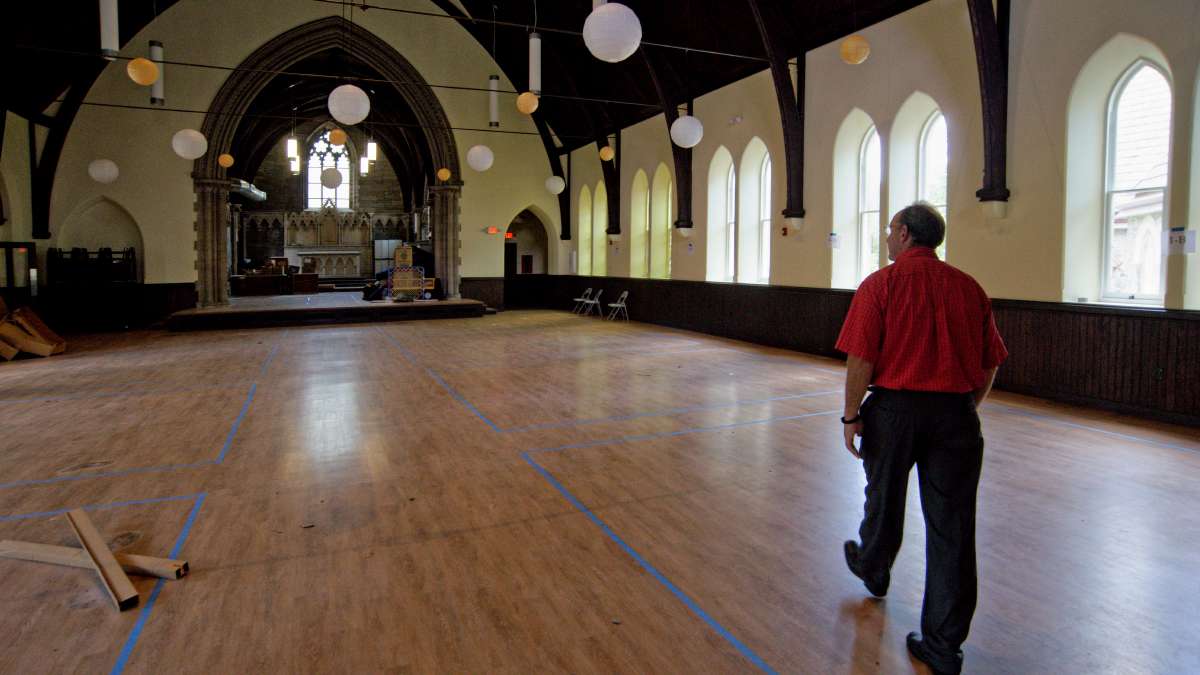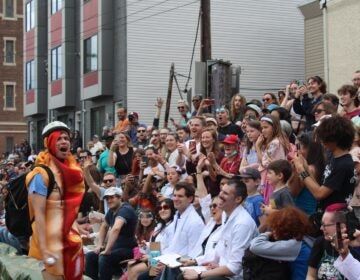Back to school and back to life for historic Germantown site
-

-

Developer Ken Weinstein is expanding his Trolley Car brand to a third location in University City. (Bas Slabbers/for NewsWorks)
-

-

-

-

-

-

-

-

-

-

-

-

-

-

-

-

-

-

At a time when many vacant church buildings in Philadelphia face deterioration and demolition, a Germantown landmark is an example of rescue and rebirth.
St. Peter’s Episcopal Church, at 6008 Wayne Ave., which was designed in 1873 by the preeminent firm of Frank Furness and George Hewitt, was listed as one of the city’s most endangered historic sites by the Preservation Alliance of Greater Philadelphia as recently as 2010.
But after a two-year, $6 million renovation that preserved four original buildings and their rich exterior and interior architectural details, St. Peter’s will be filled with energy and life once again when it opens as the Waldorf School on September 9.
What was the main sanctuary will be the school’s Great Hall, with the vaulted wood ceilings, 19th-century inscriptions and carvings, and limestone altar intact. Natural light pours into classrooms through two-story-high leaded windows. The nursery through eighth-grade students will travel through a restored Gothic stone passage that connects the main buildings.
The beauty and history of the site “affects the whole spirit of the campus,” said Anthony DeGuzman, Waldorf’s executive director.
Historic background
The St. Peter’s buildings were listed on the Philadelphia Register of Historic Places in 1965 and on the National Register in 1985. The church remained in use by its congregation until about 10 years ago.
As the vacant church, chapel, rectory and parish house deteriorated, the Episcopal Diocese of Pennsylvania removed a pair of stained glass lancet windows by the renowned local artist Violet Oakley and another pair created by Tiffany Studios. In 2010, the devotional windows were sold to and exhibited at the Pennsylvania Academy of the Fine Arts.
The Diocese battled with the Philadelphia Historical Commission for the right to remove and sell other stained glass windows, which the Diocese said would require millions to preserve in place and would deter a sale to any prospective developer. The Diocese eventually received permission to remove most of the remaining windows.
Also in 2010, Ken Weinstein, who had won awards for preserving buildings throughout Northwest Philly, took his first serious look at St. Peter’s as a possible rehabilitation project. “But I wasn’t going to pursue it without knowing who my tenant was going to be,” he said.
The Waldorf School, one of about 900 Waldorf campuses worldwide, was then renting space on the sprawling property of the New Covenant Church on Germantown Avenue in Mt. Airy, and was searching for a new home. “We were fortunate to have that massive expanse of green space” at New Covenant, DeGuzman said, but the interior rooms didn’t provide opportunity to grow.
Among the new sites Waldorf was considering was the former church at Wayne and Harvey Avenues.
“Sometime in 2012,” Weinstein said, “we got together and decided it was a good match and that we should partner on this project.”
Weinstein acquired the property for $435,000 and construction began in 2013, with the developer estimating the total cost at $4.5 million and a target completion date of Fall 2014. The extensive work needed on the leaky roofs was expected. The need for asbestos remediation in all four buildings – at a cost of $200,000 – was not expected. There were other challenges, including an interior classroom wall that listed inward by about nine inches, and the need for a rebuilt porch and new heating and plumbing systems in the what would become the administrative building.
“Anytime you restore historic buildings like this, you’re going to run into a lot of surprises,” Weinstein said. “And sometimes things take a little longer when you want the right outcome.”
While the work ran about $1.5 million beyond the original estimate, Weinstein received federal and state historic preservation tax credits to lighten the additional burden.
Waldorf has signed a 20-year lease with Weinstein for the property, with an option to purchase in 10 years. The school’s “Double Benefit” fundraising campaign began last winter and ended in July with $400,000 that will reduce rental costs and the potential purchase price. Support came from the local school community but also led to donations from the greater Waldorf family around the world, DeGuzman said.
Expanded space
The move into Germantown will have layers of benefits for the 215 students of the private Waldorf School, said DeGuzman, who became executive director a few weeks ago but has been “affiliated since 2009, as a parent primarily.”
The classrooms are about a third larger than the school’s previous location, “which enables us to support the students in different ways and support more students,” he said.
The expansion also will allow for more early childhood programs in a building renovated solely for that purpose.
The special subjects at Waldorf, including music, woodworking, “handwork” that involves knitting, sewing and doll-making, and a movement program called “eurhythmy,” will all have dedicated space on the new campus.
The Great Hall in the former main sanctuary will be used for large events, plays, musicals and artistic programs – options that didn’t exist at Waldorf’s former location. DeGuzman also hopes to bring performers and artists to the campus in order to attract residents of the neighborhood. “Our other campus was lovely, but it was disconnected from the general community,” he explained.
The student body currently comes from areas throughout the city, including West Philadelphia, Fishtown, Gladwyne and Mt. Airy. The proximity of the new campus to Lincoln Drive and the Tulpehocken train station will provide more access to students from Center City, DeGuzman said. “And I think being here in Germantown will help us attract a diverse population of families, which is something that we want. It’s part of being a part of the neighborhood.”
Walking around the campus and through the renovated buildings, DeGuzman pointed out carefully restored and adapted elements and his favorite spaces, which retained the inspired grandeur of the original design and “the sheer beauty of it all. I’ve been in the field of education for over 20 years, and I strongly believe that the physical space makes a difference in the students’ ability to learn,” he said.
The physical comforts, the natural light and new lighting, the aesthetic qualities of the buildings and the landscape – “these are all things tied to student achievement,” DeGuzman said.
The Waldorf community is also aware of the importance of reusing and sustaining the historic property. “We have an obligation to do our part to preserve this history and the physical beauty of the architecture,” he said. “I think this is a special opportunity that doesn’t come along very often.”
PlanPhilly is now a project of WHYY/NewsWorks. It began in 2006 as an initiative of Penn Praxis inside the University of Pennsylvania School of Design. Though now part of WHYY, PlanPhilly still works closely with Penn Praxis in covering planning, zoning and development news. Contact Alan Jaffe at ajaffe@planphilly.com.
WHYY is your source for fact-based, in-depth journalism and information. As a nonprofit organization, we rely on financial support from readers like you. Please give today.




